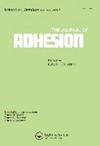改性硫酸盐木质素对环氧胶粘剂力学性能的影响:实验和理论方法
IF 2.3
4区 材料科学
Q2 ENGINEERING, CHEMICAL
引用次数: 0
摘要
本文章由计算机程序翻译,如有差异,请以英文原文为准。
Effects of the incorporation of modified kraft lignin on the mechanical properties of epoxy adhesive: experimental and theoretical approaches
ABSTRACT Several lignin-based adhesives were developed during the last decades. More recently, lignin isolation methods were improved, leading to technical grade lignins with constant properties. This recent scenario created the required conditions for the industrial use of lignin in adhesive applications, at large scale, with reliable properties. In this work, technical grade kraft lignin was epoxidized and incorporated in industrial epoxy resin, resulting into a partly biobased epoxy resin. Notwithstanding, the mechanical properties of cured partly biobased epoxy were investigated using Arcan device, aiming to reproduce realistic load conditions for the adhesively bonded joints. At last, failure envelopes were obtained from Drucker–Prager and von Mises models, revealing the most reliable model to calculate the failure prediction. Results pointed out to the development of a partly biobased epoxy adhesive with slightly superior mechanical properties, in comparison with industrial epoxy adhesive. Indeed, an important contribution was provided for the lignin revalorization and the mechanical characterization and failure prediction of epoxy adhesive based on the modified lignin.
求助全文
通过发布文献求助,成功后即可免费获取论文全文。
去求助
来源期刊

Journal of Adhesion
工程技术-材料科学:综合
CiteScore
5.30
自引率
9.10%
发文量
55
审稿时长
1 months
期刊介绍:
The Journal of Adhesion is dedicated to perpetuating understanding of the phenomenon of adhesion and its practical applications. The art of adhesion is maturing into a science that requires a broad, coordinated interdisciplinary effort to help illuminate its complex nature and numerous manifestations.
 求助内容:
求助内容: 应助结果提醒方式:
应助结果提醒方式:


